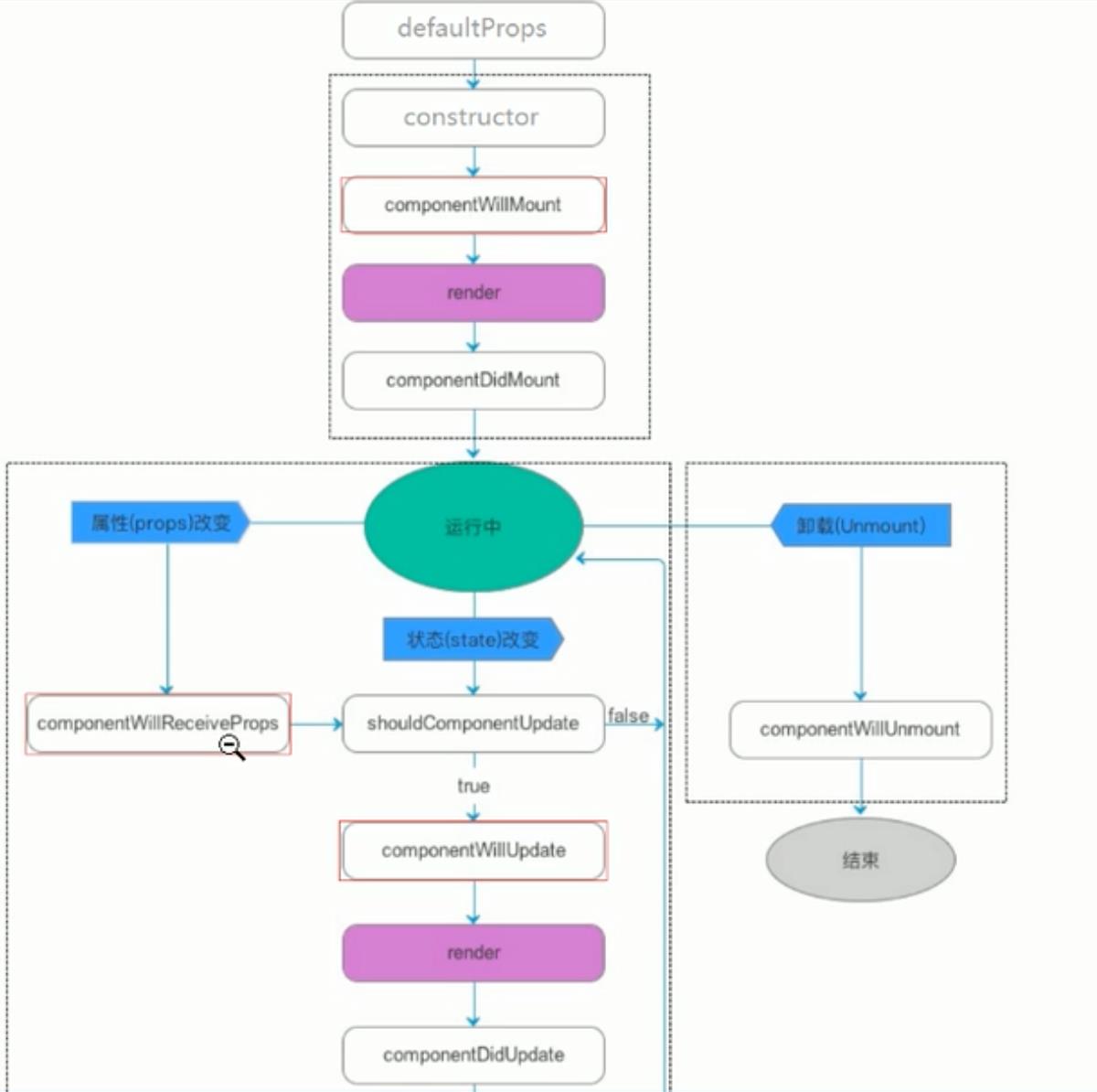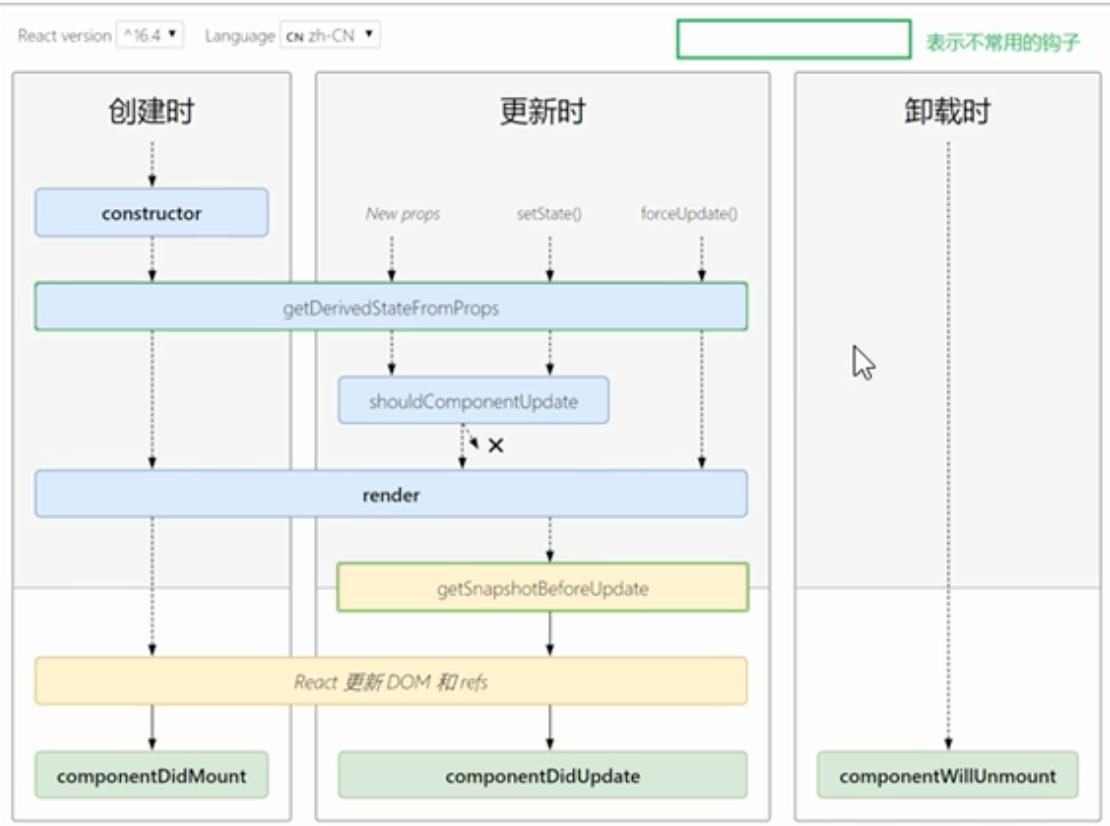React组件的使用
Posted 滴水微澜
tags:
篇首语:本文由小常识网(cha138.com)小编为大家整理,主要介绍了React组件的使用相关的知识,希望对你有一定的参考价值。
React组件简述
组件是React的一等公民,使用React就是在用组件。
组件是整个页面中的一小块,把这一小块抽成独立的,可复用的,UI小部件。
一个页面有多个组件构成,组件可复用,可以独立,可以组合。
创建组件的方式
创建组件有2种方法:创建函数组件和创建类组件。
创建函数组件
React的函数组件是一个纯函数,返回值是一个jsx对象。
/*
函数组件
1.函数名称开头字母要大写, 在使用组件时是直接把函数名当做标签
2.要有return返回值, 如果没有组件内容return null
*/
function Hello()
return (
<p>这是第一个函数组件</p>
)
//2. 将组件渲染到页面上
ReactDOM.render(<Hello/>, document.getElementById(\'rootReact\'))
// ReactDOM.render函数执行的过程
// 1.React 解析组件标签MyComponent, 找到了组件MyComponent
// 2.发现这个组件是使用函数自定义的,执行这个函数,随后将返回的虚拟DOM转成真是DOM,呈现到屏幕上
创建类组件
类组件:通过ES6的class定义一个类,在里面实现render方法
类:包含了属性和方法的对象。属性和方法是放在一起的。
对于类组件,webpack编译器解析到那个组件时,会new 这个类得到一个实例对象,然后调用这个实例的render方法。
/*
类组件
1.使用ES6的类class创建组件
2.类名的首字母为大写
3.类需要继承自React.Component
4.必须要实现render方法,在render方法中通过return返回值或者return null
*/
class World extends React.Component
render()
return (
<div>
<p>这是第一个类组件</p>
</div>
)
ReactDOM.render(<World/>, document.getElementById(\'rootReact\'))
// ReactDOM.render函数执行的过程
// 1.React 解析组件标签MyClassComponent, 找到了组件MyClassComponent
// 2.发现这个组件是类自定义组件,就new出这个类的实例对象,然后调用实例对象的render方法
// 3.随后将返回的虚拟DOM转成真是DOM,呈现到屏幕上
类组件的两大特性:变量state与生命周期。
对应的函数组件实现:State hook 与 Effect Hook。
创建一个React组件
定义一个文件,文件名称为类的名称.js
1.导入React库:import React, 为什么只需要导入React库就可以了呢?因为React组件就是返回一个JSX对象就可以了。
2.导出模块:export default 类名
3.定义一个组件【函数组件或类组件】
import React from "react";
class HelloWorld extends React.Component
render()
return (
<div>
这是第一个文件抽离组件
</div>
)
export default HelloWorld
事件绑定
类组件事件监听
类组件的事件处理函数,定义格式和复写函数的格式一样。
JS中类的定义为无序属性集合,所以类中的我们看到的属性和方法,其本质都是属性,都是key,value键值对。
在class中定义的方法可以看成是定义属性,key: value, 而在定义属性时,如果key和value的名称一样,可以简写成下面的形式而已。
而且因为是定义在类中的属性,那么调用时是已经被实例化后的实例对象,所以调用时用this.click()。
class MyBtn extends React.Component
handleClick()
console.log(\'按钮点击了\')
render()
return (
<button onClick=this.handleClick>类组件按钮:点击我</button>
)
函数组件事件监听
函数组件的处理函数,定义格式为私有函数声明的格式。
在函数中定义私有函数,只是所用域不同,定义的方式和函数组件是一样的。其实函数组件也只是一个普通的函数,只是它返回的是一个jsx对象而已。
function MyBigBtn()
function handleClick()
console.log("函数按钮被点击了")
return (
<button onClick=handleClick>函数组件按钮:点击我</button>
)
事件对象
React的事件对象e是一个合成事件,默认兼容所用的浏览器
function MyBigBtn()
function handleClick(e)
e.preventDefault()//阻止事件默认行为
console.log("函数按钮被点击了",e)
return (
<button onClick=handleClick>函数组件按钮:点击我</button>
)
React组件状态
React组件分为状态组件和无状态组件
状态组件为:类组件
无状态组件为:函数组件
状态就是React对象中的属性。
this.setState()是一个异步方法,在for循环中连续调用并不会导致状态变化,因为React会合并相同的操作。
this.setState((nextState)=>)用这个方法在for循环中连续调用,可以实现连续的变化,每次调用都有值,原因是nextState表示的是state的最新值。
函数组件的state和setState
状态state就是类组件中的数据。
import React from "react";
class State extends React.Component
//state初始化方式一
constructor()
super();
this.state =
count:0
//state初始化方式一
// state=
// count:0
//
render()
return (
<div>
计数值:this.state.count
</div>
);
export default State
setState
setState的作用:1.更改变量this.state 2.刷新UI
setState的思想:数据驱动视图
通过setState的方式修改state变量,不要直接修改
render()
return (
<div>
计数值:this.state.count
<button onClick=()=>
this.setState(
count: this.state.count+1
)
>+1</button>
</div>
);
JSX中逻辑抽离,使JSX保持结构清晰
但是会报this为undefined错误,
注意这个问题只会出现在class类组件中,函数组件是不存在的。
class State extends React.Component
incrementCount()
//this为undefined
this.setState(
count: this.state.count+1
)
render()
return (
<div>
计数值:this.state.count
<button onClick=this.incrementCount>+1</button>
</div>
);
解决方法有3中:
1.使用()=>箭头函数, 箭头函数中没有this, 所以在它里面使用的this会沿着作用域往外层找,并使用外部作用域的this,此时用的render()内的this就是组件的实例,它可以获取组件的变量, 而函数是哪个this调用它,它里面的this就是谁。
()=>this.incrementCount()
/*<button onClick=this.incrementCount>+1</button>*/ <button onClick=()=>this.incrementCount()>+1</button>
this.incrementCount = this.incrementCount.bind(this)
class State extends React.Component
//state初始化方式一
constructor()
super();
this.state =
count:0
this.incrementCount = this.incrementCount.bind(this)
incrementCount()
//this为undefined
this.setState(
count: this.state.count+1
)
3.将class实例方法改造成箭头函数的形式【推荐】
incrementCount = () =>
incrementCount = () =>
//this为undefined
this.setState(
count: this.state.count+1
)
render()
return (
<div>
计数值:this.state.count
<button onClick=this.incrementCount>+1</button>
</div>
);
表单-受控组件与非受控组件
受控组件:其值受到React中state控制的表单输入控件。
React库中要求所有组件的状态都要state来控制,通过setState来 修改。
而html中的表单组件如input输入框,却自己用于自己的状态,这个实现与react的理解不一致。
这里如果把拥有自己状态的html组件的状态也由react来管理,那么就称这个input组件为受控组件。
实现方式是,通过value="this.state.text"给组件设置状态值,通过onChange=this.handleClick来更新值的改变。
受控组件input例子
class Form extends React.Component
state=
txt: ""
handleTextChange = (e) =>
this.setState(
txt: e.target.value
)
render()
return (
<div>
<input type="text" value=this.state.txt onChange=this.handleTextChange/>
</div>
);
表单受控组件
import React from "react";
class Form extends React.Component
state=
txt: "",
content:"",
selectV:"sh",
isChecked:true
handleTextChange = (e) =>
this.setState(
txt: e.target.value
)
handleContent = e =>
this.setState(
content: e.target.value
)
handleSelectV = e =>
this.setState(
selectV: e.target.value
)
handleChecked = e =>
this.setState(
isChecked: e.target.isChecked
)
render()
return (
<div>
<input type="text" value=this.state.txt onChange=this.handleTextChange/>
<textarea value=this.state.content onChange=this.handleContent></textarea>
<select value=this.state.selectV onChange=this.handleSelectV>
<option value="sh">上海</option>
<option value="bj">北京</option>
<option value="gz">广州</option>
</select>
<input type="checkbox" checked=this.state.isChecked onChange=this.handleChecked/>
</div>
);
使用动态name属性更新状态,动态替换state中的key, 用[]包裹一个变量
handleChange = (e) =>
// 获取标签的值
const value = e.target.type === \'checkbox\' ? e.target.checked : e.target.value
// 获取标签的name属性
const name = e.target.name
// 更新动态属性的状态
this.setState(
[name]: value
)
render()
return (
<div>
/* 使用动态name属性更新 */
<input name="txt" type="text" value=this.state.txt onChange=this.handleChange/>
<textarea name="content" value=this.state.content onChange=this.handleChange></textarea>
<select name="selectV" value=this.state.selectV onChange=this.handleChange>
<option value="sh">上海</option>
<option value="bj">北京</option>
<option value="gz">广州</option>
</select>
<input name="checkName" type="checkbox" checked=this.state.checkName onChange=this.handleChange/>
</div>
);
通过ref获取在React中获取非受控组件的值,一般不推荐这种方式,推荐使用受控组件。
ref代表一个Dom,组件
先通过React.createRef()创建一个ref对象,然后把这个ref对象动态绑定到组件上,然后这个ref对象就表示这个DOM元素了。
class Form extends React.Component
constructor()
super();
this.txtRef = React.createRef()
handleClick = () =>
console.log(this.txtRef.current.value)
render()
return (
<div>
<input type="text" ref=this.txtRef/>
<button onClick=this.handleClick>获取非受控组件上的值</button>
</div>
);
组件间通信
React是组件化开发的。组件化开发就是一个页面有多个组件构成的。
而多个组件之间会存在传递信息,共享数据的需求,这里就涉及到组件的通信了。
消息传递
React中组件是一个封闭的个体,外界可以传递消息到组件内部的。
外界传递方式:
通过在标签内加属性实现。
ReactDom.render(<PropsTest name="jack" age=30 />, document.getElementById("root"))
组件内部接收方式:
函数组件是通过props参数接收
类组件是通过this.props属性接收
//类组件接收参数
class PropsTest extends React.Component
render()
let name, age = this.props
return (
<div>
类组件名字: name
<br/>
类组件年龄: age
</div>
);
//函数组件接收参数
function PropsTest(props)
return (
<div>
函数组件名字: props.name
<br/>
函数组件年龄: props.age
</div>
)
props特点
1.外部传入的参数类型可以是任意类型
2.组件内部不能修改props中的参数,因为那是只读的
3.类组件的constructer构造函数重写时,需要在内部调用super(props), 否则父组件没有将props赋值
//1.任意类型传参
ReactDom.render(
<PropsTest name="jack"
age=30
fn=()=>console.log("这是一个函数")
list=["red","blue","green"]/>,
document.getElementById("root"))
class PropsTest extends React.Component
//构造函数调用super(props)
constructor(props)
super(props);
console.log(props)
render()
// 2.props中的属性不能修改
// this.props.name = "lucy"
console.log(this.props)
let name, age = this.props
return (
<div>
类组件名字: name
<br/>
类组件年龄: age
</div>
);
组件间消息传递
1.父组件传递数据到子组件
2.子组件传递数据到父组件
3.兄弟组件之间传递数据
1.父组件传递数据到子组件
class Parent extends React.Component
constructor(props)
super(props);
render()
let name, age = this.props
return (
<div>
<Child lastName="王"/>
</div>
);
function Child(props)
return (
<div>
子组件:props.lastName
</div>
)
class Parent extends React.Component
getChildMsg= (data) =>
console.log("接收到子组件数据:",data)
render()
return (
<div>
父组件:
<Child tap=this.getChildMsg/>
</div>
);
function Child(props)
function handleClick()
props.tap("刷抖音")
return (
<div>
子组件:props.lastName
<button onClick=handleClick>点击我,传递消息到父组件</button>
</div>
)
兄弟之间的数据传递采用的是状态提升的方法,比如子组件A,子组件B它们2个共享一个状态数据,那么就可以把这个状态提升到它们共同的父组件中,然后在子组件A中调用更新方法,子组件B展示最新的状态数据。
//父组件
class Parent extends React.Component
state=
tag: \'\'
handleChange = (data) =>
this.setState(
tag: this.state.tag + " " + data
)
render()
return (
<div>
父组件:
<Child lastName=this.state.tag/>
<ChildB changeAction=this.handleChange/>
</div>
);
//子组件A
function Child(props)
return (
<div>
子组件:props.lastName
</div>
)
//子组件B
function ChildB(props)
return (
<div>
<button onClick=()=>props.changeAction("B")>传递子组件B的B到A组件中去</button>
</div>
)
Context上下文跨层传递
如果React组件,子组件,子孙组件之间要进行值传递,跨层太多时,通常需要使用Context上下文做跨层传递。
Provider : 数据的提供者
Consumer: 数据的消费者
import React from "react"; const Provider, Consumer = React.createContext()
1.在根组件的render内容部分的最外部,嵌套
class Parent extends React.Component
render()
return (
<Provider value="pink">
<div>
父组件:
<Child lastName=this.state.tag tap=this.getChildMsg/>
<ChildB changeAction=this.handleChange/>
</div>
</Provider>
);
2.在子孙组件的内部,通过内回调方法获取根组件提供的数据
function ChildBB(props)
return (
<div>
这是B组件的子组件,BB组件
<Consumer>
data => <div>通过context跨层传递的值为: data</div>
</Consumer>
</div>
)
Props深入用法
1.props.children属性
children属性可以当成是标签的一个普通属性,如果自定义组件中添加了子标签,就会在props中有这个属性,没有没有包含就没这个属性。
props.children属性的值可以像普通属性的值一样,是任意类型,标签,字符串,函数等。
function ChildA()
return (
<div>
子组件A
<ChildAA>
<button>ChildAA标签的子组件</button>
</ChildAA>
</div>
)
const ChildAA = (props) =>
console.log(props.children)
return (
<div>
props.children
子组件AA
<Consumer>
data => <div>根节点跨层传递数据data</div>
</Consumer>
</div>
)
2.props传入的类型做约束
添加组件类型约束后,如果外界传入组件的参数类型有误,就会报对应的错误,可以方便改错
//1.在项目目录下安装类型约束工具prop-types npm i prop-types //2.导入类型约束工具 import PropTypes from "prop-types" //3.为一个组件设置类型约束 ChildAA.propTypes = colors: PropTypes.array
PropTypes常用的约束类型和默认值
ChildAA.propTypes =
colors: PropTypes.array,
fn: PropTypes.func,
age: PropTypes.number.isRequired,
ele: PropTypes.element,
person: PropTypes.shape(
title: PropTypes.string,
age: PropTypes.number
)
ChildAA.defaultProps =
age: 10,
colors: [\'red\', \'blue\', \'green\']
组件的生命周期
组件的生命周期,只有类组件有,函数组件没有这个概念。
理解组件的运行方式,从组件创建,到挂载运行,到卸载销毁等组件的运行流程。
组件在生命周期的每个阶段,都会调用对应的钩子函数,它们对应了组件的生命周期阶段。
React组件有三个生命周期阶段:
1.挂载阶段
2.更新阶段
3.卸载阶段
挂载阶段
constructor -> render -> componentDidMount
class LifeCircle extends React.Component
constructor()
super();
console.warn("生命周期-挂载阶段-1:constructor")
componentDidMount()
//componentDidMount执行时,DOM页面已经渲染完成,可以进行dom操作了
//是操作DOM,发送网络请求的地方
const title = document.getElementById("title")
console.warn("生命周期-挂载阶段-3:componentDidMount", title)
render()
//每次渲染都会调用(包括:挂载阶段,更新阶段)
//render中不可用调用setState,会循环调用, setState流程做了2件事,一是更新状态数据,二是更新UI调用render方法
console.warn("生命周期-挂载阶段-2:render")
return (
<div>
生命周期组件
<h2 id="title">标题</h2>
</div>
);
更新阶段
render -> componentDidUpdate
触发更新的条件有3种:
1.调用this.setState,先更新数据状态后刷新UI
2.传入的数据由修改function Counter(props),导致刷新UI
3.this.forceUpdate(),强制刷新
class LifeCircle extends React.Component
handleClick = () =>
// this.setState(
// count: this.state.count + 1
// )
this.forceUpdate()
render()
return (
<div>
生命周期组件
<Counter count=this.state.count/>
<h2 id="title">标题</h2>
<button onClick=this.handleClick>点击更新</button>
</div>
);
//组件更新调用方法
class Counter extends React.Component
componentDidUpdate(prevProps, prevState, snapshot)
console.log("更新阶段:componentDidUpdate-2")
//此阶段一般用于Dom操作,网络发送,如果调用了this.setState必须加if判断
if (prevProps.count !== this.props.count)
this.state()
render()
console.log("更新阶段:render-1")
return (
<div>
计数器: this.props.count
</div>
);
卸载阶段
componentWillUnmount
在组件卸载时,可以处理一些清理工作,比如:清除定时器
class Counter extends React.Component
componentDidMount()
this.timerId = setInterval(()=>
console.log("定时器打印了...")
, 1000)
componentWillUnmount()
console.log("组件要被卸载了:componentWillUnmount")
clearInterval(this.timerId)
render()
console.log("更新阶段:render-1")
return (
<div>
豆豆被打了: this.props.count 次
</div>
);
老版本的钩子函数流程,红框的表示待废弃的。

新版本的钩子函数流程,绿色框标识不常用的

组件功能复用
两个组件中有相似的功能如何处理?
复用相似的功能,复用state和操作state的方法操作状态的逻辑
方式有两种:render props和 高阶组件
这2种模式是结合React特点形成的固定模式。
render props模式
render props模式表示的并不一定要是在标签上添加一个属性render
它只是一种模式,也可以将render那部分改成children
<Mouse> </Mouse>
此时在Mouse内部props.render(this.state)的调用也要改成props.children(this.state)的调用。
1.子组件内部封装状态逻辑
2.子组件通过props.render(state)将状态传递到外部
3.使用props.render(state)的return返回值作为子组件要展示的内容
render props方式实现
class ReUseComponent extends React.Component
render()
return (
<div>
父组件
//外部设置要展示的子组件内容
<Mouse render=(mouse) =>
return <p>当前坐标为:mouse.x, mouse.y</p>
/>
//猫捉老鼠
<Mouse render=(mouse) =>
return (
<img src=\'./img/cat.jpeg\'
style=position: "absolute", top:mouse.y,left:mouse.x/>
)
/>
</div>
);
class Mouse extends React.Component
state =
x: 0,
y: 0
handleMouseMove = (e) =>
this.setState(
x: e.clientX,
y: e.clientY
)
componentDidMount()
window.addEventListener("mousedown", this.handleMouseMove)
render()
//2.将state传递到外部
//3.使用props.render的返回值作为要展示的内容
return this.props.render(this.state);
children子元素方式实现
class ReUseComponent extends React.Component
render()
return (
<div>
父组件
<Mouse>
(mouse) =>
return <p>当前坐标为:mouse.x, mouse.y</p>
</Mouse>
</div>
);
class Mouse extends React.Component
state =
x: 0,
y: 0
handleMouseMove = (e) =>
this.setState(
x: e.clientX,
y: e.clientY
)
componentDidMount()
window.addEventListener("mousedown", this.handleMouseMove)
render()
return this.props.children(this.state);
另外对于工具设计需要注意点:添加类型约束和卸载处理
class Mouse extends React.Component
componentDidMount()
window.addEventListener("mousedown", this.handleMouseMove)
componentWillUnmount()
window.removeEventListener("mousedown", this.handleMouseMove)
render()
return this.props.children(this.state);
Mouse.propTypes =
children: PropTypes.func.isRequired
高阶组件模式
高阶组件是一个函数,它接收要包装的组件,返回增强后的组件。
高阶组件内部创建一个类组件,这个类组件中替换可复用的 状态逻辑 ,并通过prop将状态传递到被包装组件WrappedComponent。
1.创建一个函数,名称以with开头
2.指定函数参数,参数已大写字母开头(作为要渲染的组件)
3.函数内部创建一个类组件,提供复用的状态逻辑代码,并返回这个类
4.在类组件中渲染参数组件,并将状态传递给参数组件
5.调用高阶组件,传入要增强的组件,并返回增强后的组件,将其渲染到页面中。
function withMouse(WrappedComponent)
class Mouse extends React.Component
state =
x: 0,
y: 0
componentDidMount()
window.addEventListener("mousemove", this.handleMouseMove)
componentWillUnmount()
window.removeEventListener("mousemove", this.handleMouseMove)
handleMouseMove = e =>
this.setState(
x: e.clientX,
y: e.clientY
)
render()
return (
<WrappedComponent ...this.state/>
);
return Mouse
class PurePosition extends React.Component
render()
return (
<div>
高阶组件坐标位置:this.props.x, this.props.y
</div>
);
const MouseP = withMouse(PurePosition)
<MouseP />
高阶组件调试问题
使用高阶组件函数withMouse返回的结果组件默认在调试页面里组件的名字都一样,不好区分
解决方法是为返回的组件命名设置displayName
return Mouse.displayName = `WithMouse$getDisplayName(WrappedComponent)` function getDisplayName(WrappedComponent) return WrappedComponent.displayName || WrappedComponent.name || "Component"
高阶组件props传递丢失问题
因为在使用withMouse返回的高阶组件设置props时,在withMouse函数内部并没有将props传递给参数组件,所以需要增加传递
function withMouse(WrappedComponent)
class Mouse extends React.Component
state =
x: 0,
y: 0
componentDidMount()
window.addEventListener("mousemove", this.handleMouseMove)
componentWillUnmount()
window.removeEventListener("mousemove", this.handleMouseMove)
handleMouseMove = e =>
this.setState(
x: e.clientX,
y: e.clientY
)
render()
return (
<WrappedComponent ...this.state ...this.props/>
);
return Mouse.displayName = `WithMouse$getDisplayName(WrappedComponent)`
以上是关于React组件的使用的主要内容,如果未能解决你的问题,请参考以下文章